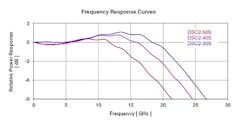Discovery Semiconductors (Ewing, NJ) high-speed, extended indium gallium arsenide (InGaAs) 2 micron photodiodes are increasingly being used for characterizing ultrafast mode-locked fiber lasers at multiple wavelengths ranging from 1550 to 2100 nm. Abhay Joshi, president and CEO of Discovery Semiconductors, said, “This technology was funded through a Phase I and Phase II SBIR by the NASA Goddard Space Flight Center. Since 2012, Discovery Semiconductors has been successfully commercializing this breakthrough technology, and are pleased to see the published results of Dr. Grzegorz Sobon’s team. At present, our emphasis is to improve the Technology Readiness Level (TRL) of these devices via upcoming Material International Space Station Experiment (MISSE) space flights. We are encouraged by the support of NASA Langley Space Center in this endeavor."
RELATED ARTICLE: Time-stretch spectroscopy STEAMs ahead
According to Dr. Grzegorz Sobon, at Wroclaw University of Science and Technology in Wroclaw, Poland, "We are using the DSC2-50S photodetectors for characterization of ultrafast, mode-locked fiber lasers. Broad operation bandwidth and high speed of the photodiode allows for acquisition of broadband radio-frequency spectra of mode-locked lasers operating at different wavelengths from the 1.5 - 2.1 [micron] range [see original SOURCE for references]. Therefore, we can use one photodiode to characterize different types of lasers (based on e.g. Erbium-, Thulium-, or Holmium-doped fibers). Additionally, the relatively high power handling is very advantageous while characterizing ultrashort (femtosecond) optical pulses with high peak power. Excellent sensitivity and low noise enabled us implementing very sophisticated measurement techniques, like dispersive Fourier transform for real-time shot-to-shot noise characterization of broadband mid-infrared supercontinuum sources [see SOURCE for additional references]."
SOURCE: Discovery Semiconductors; https://www.discoverysemi.com/news/pressreleases/press90.php

